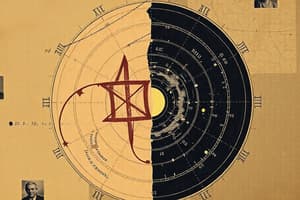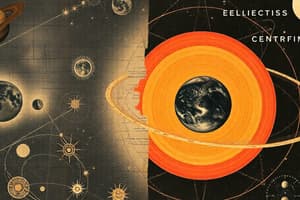Podcast
Questions and Answers
Which part of the Freudian personality is most likely to prioritize immediate gratification without considering consequences?
Which part of the Freudian personality is most likely to prioritize immediate gratification without considering consequences?
- Id (correct)
- Ego
- Conscious
- Superego
Which of the following reflects the primary role of the ego in balancing the other components of personality?
Which of the following reflects the primary role of the ego in balancing the other components of personality?
- Promoting immediate gratification of all desires to reduce internal conflict.
- Negotiating a compromise between the id's impulses and the superego's constraints. (correct)
- Suppressing the id's desires completely to adhere to moral standards.
- Ignoring the superego's moral compass.
In a scenario where an individual feels compelled to donate to charity but also wants to buy a new gadget, which personality structure is most likely dictating the charitable action?
In a scenario where an individual feels compelled to donate to charity but also wants to buy a new gadget, which personality structure is most likely dictating the charitable action?
- Ego
- Conscious
- Id
- Superego (correct)
How did pre-colonial Filipinos demonstrate scientific and technological capabilities?
How did pre-colonial Filipinos demonstrate scientific and technological capabilities?
Why are the rice terraces of the Cordilleras considered a significant engineering achievement during the pre-colonial period?
Why are the rice terraces of the Cordilleras considered a significant engineering achievement during the pre-colonial period?
Which of the following was NOT a technological or scientific advancement made by Filipinos in the pre-colonial period?
Which of the following was NOT a technological or scientific advancement made by Filipinos in the pre-colonial period?
What impact did Spanish colonization have on the technological development of the Philippines?
What impact did Spanish colonization have on the technological development of the Philippines?
How did the technological advancements during the Spanish colonial period differ from those of the pre-colonial period?
How did the technological advancements during the Spanish colonial period differ from those of the pre-colonial period?
How did the Copernican Revolution challenge established beliefs?
How did the Copernican Revolution challenge established beliefs?
Which of Kepler's laws explains why a planet moves faster in its orbit when it is closer to the sun?
Which of Kepler's laws explains why a planet moves faster in its orbit when it is closer to the sun?
What was the primary contribution of Ptolemy to astronomy?
What was the primary contribution of Ptolemy to astronomy?
How did the work of Charles Darwin impact scientific thought?
How did the work of Charles Darwin impact scientific thought?
Which of the following is a central idea of the Freudian Revolution in psychology?
Which of the following is a central idea of the Freudian Revolution in psychology?
Which of the following provides the best description of Kepler's first law of planetary motion?
Which of the following provides the best description of Kepler's first law of planetary motion?
How did the ideas presented during the Darwinian Revolution differ from previous understandings of species origin?
How did the ideas presented during the Darwinian Revolution differ from previous understandings of species origin?
According to Freudian theory, which component of the personality operates on the pleasure principle, seeking immediate gratification?
According to Freudian theory, which component of the personality operates on the pleasure principle, seeking immediate gratification?
Which of the following was NOT a health or education initiative undertaken by the Spanish government primarily benefiting the principalia class during their colonization of the Philippines?
Which of the following was NOT a health or education initiative undertaken by the Spanish government primarily benefiting the principalia class during their colonization of the Philippines?
What was the primary purpose of the Bureau of Science, established during the American occupation of the Philippines?
What was the primary purpose of the Bureau of Science, established during the American occupation of the Philippines?
Which factor was NOT identified as contributing to the deterioration of science in the Philippines during the post-colonial period, leading to the creation of the National Science Development Board (NSDB)?
Which factor was NOT identified as contributing to the deterioration of science in the Philippines during the post-colonial period, leading to the creation of the National Science Development Board (NSDB)?
Which organization was NOT established as one of the policies formulated for the development of science and to coordinate the work of science agencies during the Post-Colonial Period?
Which organization was NOT established as one of the policies formulated for the development of science and to coordinate the work of science agencies during the Post-Colonial Period?
In what way did the American occupation differ from the Spanish colonial period in terms of promoting science and technology in the Philippines?
In what way did the American occupation differ from the Spanish colonial period in terms of promoting science and technology in the Philippines?
During which period were the Philippine Atomic Energy Commission (PAEC) and the National Institute of Science and Technology (NIST) created to coordinate scientific efforts?
During which period were the Philippine Atomic Energy Commission (PAEC) and the National Institute of Science and Technology (NIST) created to coordinate scientific efforts?
What impact did the change from colonial rule to independence have on the development of science and technology in the Philippines?
What impact did the change from colonial rule to independence have on the development of science and technology in the Philippines?
What was a commonality between the Spanish Colonial Period and the Post-Colonial Period regarding advancements in the Philippines?
What was a commonality between the Spanish Colonial Period and the Post-Colonial Period regarding advancements in the Philippines?
Flashcards
Id
Id
The impulsive part of the personality, driven by pleasure and avoiding pain.
Superego
Superego
The moral and judgmental part of the personality.
Ego
Ego
The conscious part of the personality that mediates between the id and superego.
Pre-colonial medicine
Pre-colonial medicine
Signup and view all the flashcards
Pre-colonial agriculture
Pre-colonial agriculture
Signup and view all the flashcards
Pre-colonial transport
Pre-colonial transport
Signup and view all the flashcards
Rice terraces
Rice terraces
Signup and view all the flashcards
Spanish colonial construction
Spanish colonial construction
Signup and view all the flashcards
Geocentric Theory
Geocentric Theory
Signup and view all the flashcards
Heliocentric Theory
Heliocentric Theory
Signup and view all the flashcards
Kepler's First Law
Kepler's First Law
Signup and view all the flashcards
Kepler's Second Law
Kepler's Second Law
Signup and view all the flashcards
Kepler's Third Law
Kepler's Third Law
Signup and view all the flashcards
Darwin's Theory of Evolution
Darwin's Theory of Evolution
Signup and view all the flashcards
Freud's Psychoanalytic Theory
Freud's Psychoanalytic Theory
Signup and view all the flashcards
Principalia Class
Principalia Class
Signup and view all the flashcards
Colegio (Spanish Era)
Colegio (Spanish Era)
Signup and view all the flashcards
San Lazaro Hospital (1578)
San Lazaro Hospital (1578)
Signup and view all the flashcards
Bureau of Science (1905)
Bureau of Science (1905)
Signup and view all the flashcards
University of the Philippines (1908)
University of the Philippines (1908)
Signup and view all the flashcards
National Science Development Board (NSDB)
National Science Development Board (NSDB)
Signup and view all the flashcards
PAEC and NIST
PAEC and NIST
Signup and view all the flashcards
The Philippine Inventors Commission (1964)
The Philippine Inventors Commission (1964)
Signup and view all the flashcards
Study Notes
- Intellectual Revolutions
Geocentric Theory
- Claudius Ptolemy, a famous philosopher and astronomer, theorized that the planets, sun, and moon moved in circular motion around the Earth.
- Ptolemy believed the Earth was the center, also known as geocentrism.
- Ptolemy's geocentric model was widely accepted and considered a major discovery.
Copernican Revolution
- Nicolaus Copernicus, a Polish mathematician and astronomer, challenged the Ptolemaic model in the 16th century.
- Copernicus introduced heliocentrism, which suggested that the sun, not the Earth, was the center of the Solar System.
- Heliocentrism was initially rejected, conflicting with religious beliefs about the Earth's creation.
Kepler's Laws
- Johannes Kepler formulated three laws of planetary motion.
- Kepler's laws accurately describe the motion of comets.
- Kepler's first law: Planets move in elliptical orbits around the sun, with the sun at one of the ellipse's two foci.
- Kepler's second law: A line joining a planet and the sun sweeps over equal areas during equal intervals of time.
- Kepler's third law: The cube of a planet's mean distance from the sun is proportional to the square of the time it takes to orbit.
Darwinian Revolution
- Charles Darwin, published "On the Origin of Species" in 1859.
- Darwin introduced the theory of evolution.
- Populations pass through natural selection, where the fittest survive.
Freudian Revolution
- Sigmund Freud changed psychology with his psychoanalysis theory in the late 19th century.
- Conscious and unconscious factors influence behavior and emotions.
- Personality is a product of three conflicting elements: id, ego, and superego.
- The id is impulsive, driven by pleasure, and repulsed by pain.
- The superego is judgmental and morally correct.
- The ego mediates between the id and superego, making decisions.
Science Technology and Nation Building in the Philippines (Pre-Colonial Period)
- Scientific and technological development began in the pre-colonial Philippines.
- Early Filipinos used plants and herbs as medicine.
- Farming and animal-raising systems existed.
- Filipinos developed methods of transportation.
- Rice terraces were built by hand in the Cordilleras with a complicated irrigation system.
- Iron ores were extracted.
- Filipinos learned to weave cotton and make glass ornaments.
- Lowland rice dike fields and terraced fields were cultivated, and boats were built.
Science Technology and Nation Building in the Philippines (Colonial Period)
- Colonization by the Spaniards provided the Philippines with modern construction methods.
- Walls, roads, and bridges were built using engineering skills and tools brought by the Spaniards.
- The Spanish government developed health and education systems mainly for the principalia class.
- Schools and hospitals were established during this period, including:
- Colegio de San Ildefonso (Cebu, 1595)
- Colegio de San Ignacio (Manila, 1595)
- Colegio de Nuestra Senora del Rosario (Manila, 1597)
- Colegio de San Jose (Manila, 1601)
- University of Santo Tomas (Manila, 1611)
- Hospitals established include:
- San Lazaro Hospital (1578)
- Hospital de Los Banos (1590)
- San Juan de Dios (1596)
- Chinese General Hospital (1891)
- The bridge in Tayabas, Quezon, is a five-span, 445 ft (136 m) long stone arch bridge built during the Spanish colonial period and is one of the oldest and longest bridges from that era.
- American occupation modernized the Philippines.
- The Bureau of Science was established in 1905 to develop science and technology.
- Schools, universities, boards and bureaus were established, including:
- Bureau of Science (1905)
- University of the Philippines (1908)
- The growth of higher education increased the number of scientists and engineers.
Science Technology and Nation Building in the Philippines (Post-Colonial Period)
- The Philippines continued pursuing science and technology programs after independence.
- The National Science Development Board (NSDB) was created because of a deterioration of science, lack of government support, lack of scientists, and lack of public awareness.
- Policies were formulated to develop science and coordinate the work of science agencies, such as:
- Philippine Atomic Energy Commission (PAEC)
- National Institute of Science and Technology (NIST)
- The Philippine Inventors Commission (1964)
- The Philippine Coconut Research Institute (1964)
- The Philippine Textile Research Institute (1967)
- The Forest Products Research (1969)
- Ferdinand Marcos ushered in advancements with agencies like:
- Philippine Atmospheric Geophysical and Astronomical Services Administration (PAGASA)
- National Academy of Science and Technology (NAST)
- National Science and Technology Authority (now the Department of Science and Technology (DOST))
Studying That Suits You
Use AI to generate personalized quizzes and flashcards to suit your learning preferences.




